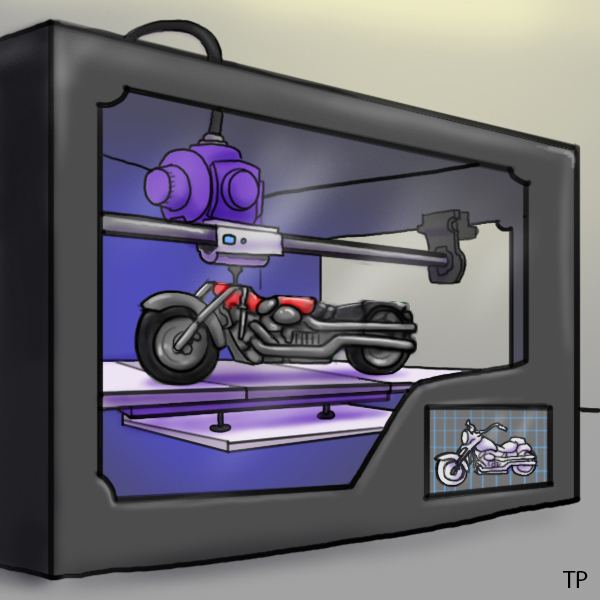
3D Printing: First retail website that ONLY sells 3D printers to the public and has sold at least
1,000,000 multi-material 3D printers. Their "multi-material" printer must be able to use at least one metal, one plastic, one glass, and one organic material "feeder" stocks plus at least one lubricant. The website must sell 3D printers in at least three sizes: small, medium, and large. The small 3D printers are to be the size of a microwave oven, the medium ones are to be large enough to print a two-door refrigerator/freezer, and the large is big enough to print a four-door sedan car. The medium and large printer must be designed to be kept in a garage. Anything that the small printer can make, the large printer must be able to make. All printers being able to be shipped through a parcel delivery company.
[This challenge is in this category due to the lack of waste 3D printing generates.]
Future Challenges:
1) ...over 1,000,000 designs FREE to the public, including those who have not purchased a 3D printer through them. The designs must be of the most popular items which the public seeks from 3D printers, including bicycles, motorcycles, cars, pick-up trucks, clothes washers, clothes dryers, microwave ovens, stoves, frying pans, cooking pots, knives, refrigerators, desks, desk chairs, lounge chairs, recliner chairs, three-cushion sofas, twin beds, king-size beds, six-drawer dressers, desks, ink pens, 100-inch flat-screen TVs, laptop computers, shower curtains, desk lamp, standing lamp, tennis shoes, coats, pants, shirts, underwear, etc. [The idea is to eliminate the buying obstacle of expensive patents for stuff people want to print up as a reason not to get a 3D printer.]
2) ...3D printers that can also recycle previously printed items and reuse the recycled material in producing future items.
3) ...a food 3D printer that can print every food item in a Walmart grocery store.
4) ...a super-large 3D printer to print entire homes. Due to its likely high ticket price, home construction companies will be the ones with the financial wherewithal and demand for these printers. The super-large printer will only need the construction company to dig out the basement whereupon they will then lower the printer onto a level "starter plate" and the machine then starts to build the house from the floor of the basement up. The "starter plate" isn't the floor of the basement but what the floor of the basement will be printed upon. After the basement is completed, the construction company fills in the dirt around the house as the machine continues to build upward. To win this challenge, the home construction company must be the first to 3D print at least 100 homes, each of which must have at least four bedrooms and five bathrooms (one per bedroom and one for visitors), at least a two-car garage, and, in the northern hemisphere, all of its south-facing roof tiles be solar tiles. So this construction doesn't take forever, expect these 3D printers to have row after row of printers going in the same direction and then looping back around to make another pass. [These massive 3D printers will cost a fortune BUT that's fine. That gives consumers a reason to hire home construction companies to build ("print") their homes and not simply print them themselves. Home construction companies will then compete against each other by how large and advanced their 3D printers are and the home designs they can produce. And once one of these 3D printers is placed on its starter plate, the construction only needs one person there to troubleshoot problems. The company could even have one troubleshooter oversee possibly twenty or more homes under construction. Of course, that means the company will need to employ three troubleshooters since the printers will operate 24 hours a day until they're done.]
5) ...a gigantic 3D printer that can print ships up to the size of the largest (at that time) oceanliners and oil tankers. Like the home construction 3D printers, these printers will likely only be sold to shipyards due to their HUGE price tags. The printers being so expensive partly because there will be a very small (though well-heeled) demand for them. Also, like the home construction 3D printers, these ship 3D printers will have row after row of printers (possibly more than a hundred) going in the same direction and then looping back around to make another pass. Unlike the home construction 3D printers, these ship-building 3D printers will likely have a large team of technicians overseeing them around the clock.
